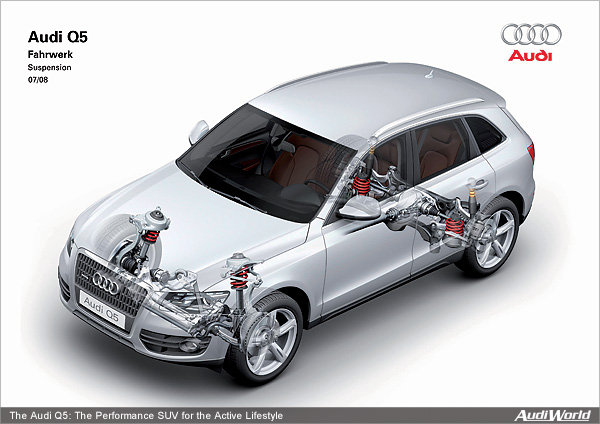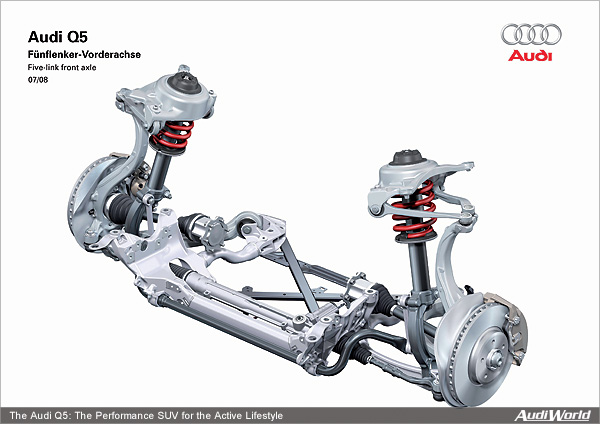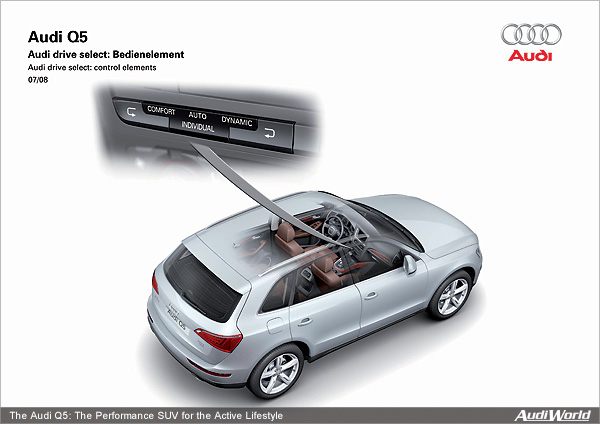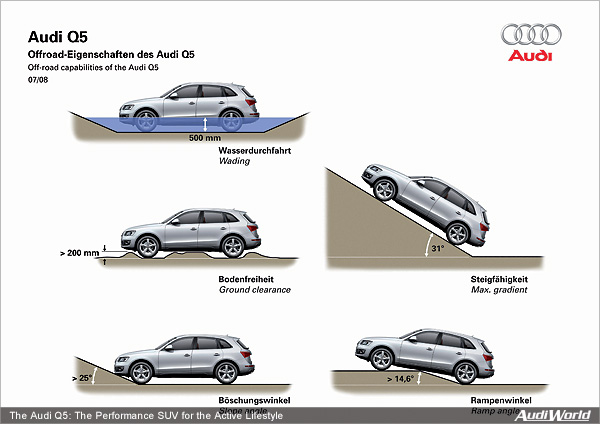Audi Q5: The Running Gear

Two innovative technologies enhance the driving experience yet further the adaptive control system Audi drive select, and Audi dynamic steering. The Audi Q5 also excels on rough terrain. Its ESP and ABS use special characteristic maps for off-road driving, and there is a special function to assist the driver during steep descents.
The five-link front suspension, with an ample track width of 1,617 millimeters (63.33 in), is a big factor in the dynamic character of the Audi Q5. Because the development engineers moved the differential further forward up the driveline and the clutch further back, the axle could be positioned well to the front.
This configuration permits an optimal weight distribution between the front and rear axles. The battery housed in the cargo area and the rear-axle differential of the standard quattro drive underpin this equilibrium.
Lightweight aluminum a material in the use of which Audi possesses an unequalled level of experience is used in many areas. For example the largest and most complex running gear component, the subframe for the engine and front axle, is made from aluminum. Rigidly bolted to the forward structure, it forms part of the body and its high rigidity transmits steering forces without any delay.
Lightweight construction: aluminum links
Aluminum is also used on the Audi Q5 for the bearing mount that links the upper suspension control arms with the body and for the pivot bearing. The front suspension comprises five links per wheel one support link and one control arm at the bottom and two control arms at the top. The fifth link is the tie rod that connects the steering gear with the pivot bearing.
All suspension control arms are forged aluminum parts, guaranteeing low unsprung masses and extremely precise wheel location. The anti-roll bar is made from a high-strength tube, a design that also saves weight.
The arrangement of the control arms reduces the leverage exerted by driveline and external forces, so that the driver does not feel them at the steering wheel. The steering is exactly centered during straight-line travel, assuring a precise steering feel from the center position; the initial response feels balanced, even at high speeds.
The five-link front suspension handles longitudinal and lateral forces separately when the car is in motion. In the lateral direction the bearings are rigid, enhancing sporty precision and high cornering speeds. In the longitudinal direction, on the other hand, they have a supple, soft response, combining the dynamism of a sports sedan and the comfort of a full-size vehicle.
The rear axle of the Audi Q5, with its track of 1,613 millimeters (63.50 in), is inspired by the self-tracking trapezoidal-link rear suspension layout of the large A8 and A6 car lines. It combines excellent drivability and ride comfort with compact packaging. Whenever the Q5 is used for sport and leisure, it offers great advantages: the loading lip and floor are at a low height, and the floor is flat.
A torsion-proof, non-flexing subframe welded together from two longitudinal and two lateral tubes of higher-strength steel form the backbone of the rear suspension. Its longitudinal tubes are manufactured by hydroforming, which involves extremely high water pressures. Four large rubber mounts connect the subframe with the body. They are particularly firm in the transverse direction for dynamic handling, but have a soft response vertically and longitudinally in the interests of comfort.
The unsprung masses have again been kept to the absolute minimum at the rear axle. The two trapezoidal links are warm-hardened aluminum castings; the wheel carriers are of chill-cast aluminum. The upper control arms and the track rods are aluminum forgings. The anti-roll bar, designed as a tube like at the front axle, likewise combines low weight with high rigidity.
Separate: the springs and dampers
The springs are supported directly on the wheel carriers an arrangement that has made it possible to increase the ride comfort to luxury-car level and improve the road dynamics to the standard of a sports sedan. The separate springs and dampers also improve response; special rubber formulations in the axle mounts improve boost comfort further. The new rear suspension kinematics keep brake dive closely under control, and in this way add to the car’s sporty, dynamic appeal.
The standard suspension provides a generous 214 millimeters (8.43 in) of travel at the front and 230 millimeters (9.06 in) at the rear. As an option, Audi can also supply Drive Select in combination with adaptive shock absorbers, the response of which can be adjusted across a range from comfortable to dynamic. For an even more intense sporty character, there is the S line sport suspension. The damping response is a touch firmer in this instance.
Whichever setup it has, the Audi Q5 is the sportiest SUV in its class. It handles with agility and playful ease, offers a spontaneous and willing steering response, and behaves almost neutrally at the handling limits. Its steering provides subtly differentiated feedback from the road, and when coming out of a bend the quattro permanent all-wheel drive provides powerful traction early on. All these strengths are typical of Audi, and in combination they create a fascinating picture of driving enjoyment, dynamic handling and comfort.
The Audi Q5’s steering gear is located well forward, deep in the forward structure, just below the front axle on the subframe. This means that movement of the steering wheel is transmitted to the wheels in a very direct manner by the track rods, providing immediate steering response. The steering column is bolted onto the module cross-member in a torsion-proof arrangement; this member, which is the backbone of the cockpit, is in turn connected to the body by the bulkhead bearing mount. This strong combination further enhances the precision of the steering response.
Worthy of a sports sedan: the steering
The steering gear is a rack-and-pinion design with an aluminum steering-gear casing. With a ratio of 16.1:1, the steering is as agile and direct as in a sports sedan, without coming across as twitchy. A regulated vane pump supplies the system with hydraulic energy it only delivers as much oil as is necessary at any given operating point. This low energy consumption improves the Audi Q5’s fuel efficiency by about 0.1 liter per 100 km.
The Audi Q5 comes with servotronic as standard. Configured as a speed-dependent power steering system, it requires only little effort from the driver to maneuver into a parking space thanks to the high servo assistance. At higher speeds it trims back the level of servo assistance, for a superbly calm response on the freeway.
The wheels range, too, underscores the dynamic character of the Audi Q5. Audi ships its new performance SUV fitted with elegant alloy wheels in four substantial dimensions 17, 18, 19 and 20 inches. All three engine versions come with factory-fitted size 8 J x 17 forged wheels equipped with size 235/65 tires. Alternatively Audi can supply cast wheels in the same dimension, and 7 J x 17 winter wheels.
The size 8 J x 18 cast alloy wheels standard on the 2.0 TFSI and 3.0 TDI with 235/60 tires are available in versions with six or ten arms. There are also two versions of the optional 8 J x 19 wheels with 235/55 tires a particular highlight being the machine-polished version painted brilliant silver. The largest wheel size available is 8.5 J x 20 and comes with 255/45 tires.
The standard-fit second-generation tire pressure monitoring display is a very clever system. A software-only concept, it does not require any wheel-mounted components. By monitoring the tires’ vibration it detects a rapid loss of pressure in the event of tire failure and also senses which wheel is affected.
The system also notices if all four tires are slowly losing air at an equal rate this effect, which is caused by diffusion, may amount to up to 0.1 bar per month. The tire pressure monitoring display requires no servicing or consumables such as new batteries.
Large and powerful: the brakes
The large wheels of the Audi Q5 conceal brakes that are easily up to whatever braking tasks they may be confronted with. The 2.0 TFSI and 2.0 TDI with four-cylinder engines have 320 millimeter (12.60 in) diameter front disks, and 300 millimeter (11.81 in) disks at the rear. The high-performance brake pads achieve high, stable coefficients of friction and are only minimally susceptible to fading even under extreme loads. The ventilated front disks no longer have any conventional cooling ducts. Instead, the two halves of the disk are joined together by hundreds of small metal cubes that are able to dissipate a high volume of hot air very rapidly.
The 3.0 TDI is fitted with composite aluminum calipers. All four disks of diameter 345 millimeters (13.58 in) at the front and 330 millimeters (12.99 in) at the rear are ventilated. The brake calipers have a composite design based on the floating-caliper concept. Areas calling for maximum load resistance are made from high-strength spheroidal-graphite cast iron. The aluminum piston housing dissipates the heat very effectively; despite their low weight the brake calipers exhibit extremely high rigidity.
All brake disks and also the aluminum cover plates are particularly light in weight directly benefiting the sporty handling, by reducing the unsprung masses. The design of the calipers and rims also benefits the customer in a very tangible way: the mechanic can gauge the remaining thickness of the brake pads the moment a car is brought in for servicing, without needing to remove the wheels.
The ESP stabilization system, too, emphasizes the Audi Q5’s sporty behavior. It operates with a new type of high-precision hydraulic valves that manage the pressure buildup with particular accuracy. It runs without any of that all-too-familiar jolting, or obvious vibrations.
The ESP can be switched to the off-road mode at the push of a button. If the driver briefly presses the button at less than 70 km/h (43.50 mph), the traction control component is shut down. This largely prevents engine-management intervention and weakens the system’s brake applications. The system now permits certain sideslip angles that are nevertheless still safe something that sporty drivers will really relish.
The ESP in the new Audi Q5 includes a whole bundle of other functions. Under extreme loads, it compensates for the fading effect that is triggered off by hot brakes. In wet weather, it clears the water film off the brake disks by applying the brakes briefly at intervals to an extent that remains unnoticed by the car’s occupants. And it stabilizes a trailer that is threatening to fishtail by acting on the wheels of the towing vehicle, braking them individually and out of phase with the vibrations.
Roof rack identification is a novel supplementary function. The ESP detects by means of a sensor on the rails whether the roof cross-member supplied as standard with the car is fitted and consequently whether the Audi Q5’s center of gravity has moved higher. If so, it modifies its control strategy to cut in slightly sooner around the handling limits. This second characteristic map has enabled Audi’s suspension engineers to give the Audi Q5 a decidedly sporty characteristic for normal operation.
New dimension to driving enjoyment: Audi drive select
Like the Audi A4 and A4 Avant, with which it shares a production line, the Audi Q5 can be supplied optionally with the driving dynamics system Audi drive select; this is available for all three engine versions. It takes the performance SUV into a new dimension of drivability.
Audi drive select is designed as a modular system. In combination with dynamic steering and/or the adaptive shock absorbers, it fundamentally also accesses three other components the engine, the seven-speed S tronic (optional for 2.0 TDI) and the servotronic steering (optional for 2.0 TDI). The engine’s throttle response, the dual-clutch transmission’s shift points and the servotronic’s speed-dependent power assistance can all be programmed according to three characteristic maps.
The driver can change between the operating modes of these technical components using two arrow keys on the center console; whichever characteristic map is active is shown lit up. The “comfort” mode is ideal for relaxed driving on long journeys and over poor road surfaces, or for urban traffic. “auto” is the most balanced setting and “dynamic” the sportily firm stage in which the running gear can demonstrate the full scope of its talents. All changeovers take place safely and smoothly and are always clearly detected by the driver, without becoming a distraction their finesse the result of exhaustive test series.
If the Audi Q5 is fitted with the MMI navigation system plus, there is a fourth characteristic map with the name “individual” available. It allows the driver to configure their own preferred parameters from two dozen options, via the MMI terminal. Although an even wider choice would be technically possible, it would result in a complexity that would be at odds with the Audi principle of intuitive operation. If different people use the Q5, their individual settings can be saved on separate keys.
High tech from Audi: the adaptive shock absorbers
Two innovative technologies can be combined with drive select: Audi dynamic steering, and electronic control for the shock absorbers. Their nerve center is an ultra-responsive control unit. Its computer continuously analyzes the signals from 14 sensors, and calculates the current for the electrically governed shock absorbers at each individual wheel every millisecond.
The CDC (continuous damping control) shock absorbers are hydraulic gas-filled units. An electromagnetically triggered valve regulates the flow of hydraulic fluid between the inner and outer shock-absorber tubes.
Using the Audi drive select characteristic map, the control unit adapts to the driver’s style and the condition of the road. If the driving style is sporty, the computer selects small flow cross-sections and therefore high damping forces, thus minimizing body movements; in urban traffic it selects large cross-sections and low forces to boost comfort.
The CDC dampers are combined with sports suspension springs. Because these hi-tech dampers are able to realize lower damping forces than conventional components, they allow the car to adopt the same smooth elegance as with the standard suspension.
The harmonic drive gearing
The Audi dynamic steering in the Q5 is a technology that opens up a new chapter of automotive history. A backlash-free superposition gear in the steering column changes the ratio depending on the road speed. At the handling limits on bends, it is capable of stabilizing the performance SUV by applying minor adjustments to the steering with lightning speed. The superposition gear is integrated into the steering column and driven by an electric motor. It is also known as a harmonic drive, a principle that has already been tried and tested in aerospace technology.
Its strengths are displayed in all key areas of technology. The drive operates without any backlash and is therefore extremely precise, with low friction; it can transmit very high torques and operates at a high level of efficiency. Yet it is extremely compact, light in weight and torsionally resistant to torsional stresses.
The Audi dynamic steering in the Q5 can vary its ratio by almost 100 percent, depending on the car’s road speed and the chosen Audi drive select mode. Transitions are continuous and imperceptible. System involvement is very direct when parking. Drivers can cover the entire steering range in just two turns of the wheel a maneuver made nearly effortless, thanks to a high level of power assist. At moderate highway speeds, the system becomes less direct and provides less power assist. At top speeds, an indirect steering ratio and low level of power assist make it easy to keep the vehicle in its lane.
The dynamic steering system cooperates closely with ESP in the vehicle dynamics and safety areas. It relieves the burden on the electronic stabilization program for the simple reason that a steering correction can be performed much faster than the time needed to build up pressure for a brake application. This rapid adjustment of the steering eliminates the need for frequent braking and generates extra smoothness and dynamism. Despite their enormous effect, drivers generally do not notice the corrections.
One classic critical situation is if the vehicle’s tail end skids out of control the Audi dynamic steering in the Q5 significantly reduces the fear factor. The system can rectify a minor to moderate angle of attitude by countersteering. Only if the angle is more significant do the brakes also come into play. The new technology furthermore intervenes in the event of understeering. The steering ratio is made more indirect for a short time, so that the driver is unlikely to turn the wheel beyond the limit of good tire grip.
Another type of critical situation occurs when the car is braked on surfaces where the level of grip varies. The side of the car with the better tire grip and braking force pulls the car away from the chosen line. Audi dynamic steering resolves this problem largely on its own. Just about all the driver needs to do is turn the steering wheel in the desired direction of travel.
Sheer poise: impressive performance off-road, too
The Audi Q5 demonstrates the same poise in off-road conditions that it exhibits on roads and bends of all kinds. Here, it supplies further proof of its capabilities in the basic concept adopted for its running gear and body. Its axles allow diagonal warpage of up to 160 millimeters (6.30 in), and the climbing performance is an exceptionally high 31 degrees. Thanks to the short overhangs, the angles of approach and departure are all of 25 degrees. The ramp breakover angle an ascent with a kink where the wheelbase and ground clearance really matter measures 17.6 degrees, and the lateral incline 25 degrees. The ground clearance is a substantial 20 centimeters (7.87 in) and wading at a depth of up to 50 centimeters (19.69 in) is handled with ease.
On the right edge of the switch strip on the center console there is a button that makes steep descents safer. At speeds within the range of 9 to 30 km/h (5.59 to 18.64 mph) hill descent assist, a special ESP function, holds the car’s speed constant at the speed when the button is pressed. It does this initially by using the engine drag torque; if that on its own is not enough, the brakes on all four wheels are applied to precisely the degree required.
The ESP and ABS in the Audi Q5 have been extended by separate characteristic maps for off-road operation. If the driver briefly presses the “ESP-off” switch when driving off road, the system switches to a mode in which it attenuates braking and engine intervention and concentrates on maximizing traction. The ABS analyzes the surface conditions on the basis of wheel vibrations and selects the ideal control strategy for sand, gravel or scree. This usually produces a relatively harsh response that allows the tires to push along a wedge of material in front of them, thus enhancing the braking effect.
The equipment, data and prices stated here refer to the model range offered for sale in Germany. Subject to amendment; errors and omissions excepted.
|



